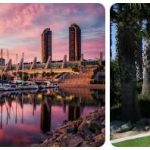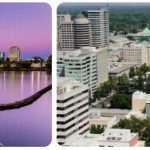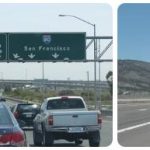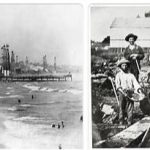Introduction
Los Angeles (abbr.: LA), city in the United States of America, in the south of the state of California, on the Pacific Ocean, with 3.5 million inhabitants. The Los Angeles-Anaheim-Riverside metropolitan area has approximately 14.5 million inhabitants, or nearly half of the state’s total population. The city is one of the largest three cities in the country.
Functions
The city is one of the largest industrial, financial, and commercial centers in the United States. The industry is extensive and varied and mainly includes the production of aircraft and electronic equipment, the film, television and music (Hollywood) industries, as well as the manufacture of electrical equipment, electronics, machinery, sanitary ware, construction materials and petrochemical products. and the canning of foodstuffs (especially sea fish, shellfish, meat and fruit). The city is also a center of aerospace industry. Within the city limits and in the immediate vicinity are several petroleum fields (Wilmington) and petroleum refineries.
The harbor in San Pedro Bay is the busiest port on the US west coast. The city is the starting point for several transcontinental rail lines and has one of the busiest airports on the American west coast (Los Angeles International Airport [LAX]). Partly due to the (currently) lack of a functional public transport system, the city has the largest concentration of automobiles in the world. Work is underway on a modern public transport system, a combination of metro and express tram. The first line was put into service in 1993 in Los Angeles. It is surrounded and intersected by an intricate network of freeways centered on Stack, located on the northern edge of downtown (Downtown LA). a multi-storey traffic circle that directs traffic from downtown to the various suburbs and boroughs (Long Beach, Pasadena, Santa Ana; Wilmington, San Pedro, Beverly Hills, Santa Monica). One of Los Angeles’ biggest problems is environmental pollution; the smog, a combination of fog, factory smoke, exhaust fumes and other air-polluting elements, often takes on such serious forms on warm, windless days that public health is threatened.
In terms of education, Los Angeles is central to California; the most important institutions with university status are the University of California (UCLA; 1919), California State University (1947), the University of Southern California (1879; Methodist, with library from 1880), Loyola Marymount University (1973, Catholic; originally founded in 1911 by Jesuits), West Coast University (1909) and various colleges, including Mount St. Mary’s College (1925), Occidental College (1887) and the Otis Art Institute of Parsons School of Design ( 1918). In addition, there are a number of important suburban educational institutions, such as the California Institute of Technology in Pasadena. There are several large theatres, concert halls (including the Music Center, 1964) and Libraries (Public Library, 1872). Well-known museums include the Los Angeles County Museum of Natural History (1910; extensive collection of the natural history of the North American continent), the Museum of Contemporary Art (1986), George C. Page La Brea Discoveries Museum (fossils) and the impressive Griffith Planetarium (1935).
In addition to its own orchestra, Los Angeles also has an opera company and a large number of theater companies. In addition, in the city or in the immediate vicinity there are the amusement park Disneyland (1955), Forest Lawn Memorial Park, various stadiums, including the Memorial Coliseum (substantially renovated for the 1984 Summer Olympics), racecourses of Hollywood Park and Santa Anita, and harbors with facilities for water sports (surfing) and sport fishing, such as Marina del Rey. Santa Catalina Island, Mount Wilson Observatory, Fort MacArthur, Marineland of the Pacific and the harbor installations in San Pedro Bay also attract many visitors.
Cityscape
The heart of the city is formed by the almost flat downtown Los Angeles (the business center), with many public buildings and the main shopping centers; decentralization (among other things due to the ban on building higher than 50 m in force until 1957 due to the danger of earthquakes) has led to the appearance of modern, luxurious shopping centers in most districts of the city. After the ban was lifted, numerous skyscrapers appeared in a short time (Bunker Hill Towers, Security Pacific Building, Atlantic Richfield Plaza; United California Bank Building, 1973-1974). Also nearby are Chinatown and the Japanese colony of Little Tokyo.
Los Angeles has a number of beautiful parks, such as Griffith Park (with zoo), open-air theater, Griffith Planetarium and Gene Autry Western Heritage Museum (1988; history of the American West). The old mission church (1814-1822) built by the Spanish Franciscans is one of the city’s oldest buildings; Also interesting is the El Pueblo de Los Angeles State Park, which includes the historic core of the city founded in 1781.
History
On Aug. 1, 1769, an expedition led by the Spaniard Gaspar de Portolá reached the Indian village of Yang-na, which the next day, the day of ‘Our Lady, the Queen of Angels’ (Spanish: Nuestra Señora la Reina de los Angeles) was called Los Angeles. As the capital of a Mexican province, Los Angeles was the last place to surrender to the Americans in 1847. In 1850 it received city rights from the United States. With the creation of a railroad network (from 1880), the opening of the harbor (1914), and through annexations, Los Angeles expanded faster than any other major city in the United States (1900: 102?500 pop, 1930: 1, 2 million, 1950: 1.9 million, 1960: 2.4 million, 1970: 2.8 million, 1980: 3 million). The city has, partly because of the pleasant climate and the film industry, an enormous attraction for artists, writers, fortune seekers and eccentrics since the beginning of the 20th century, which is reflected in, among other things, strong emerging movements and fads from time to time. In stark contrast to the glitz and glamor are the run-down neighborhoods where unemployment and poverty reign.
In 1965, 34 people died in protests. Massive riots broke out in 1992 when four white police officers were acquitted of molesting a black man despite an incriminating video recording. 58 people were killed in these riots. A year later, two of the police officers were convicted. At the end of 1993, forest fires caused extensive damage to the suburbs. An earthquake in January 1994 killed 57 people and destroyed or damaged thousands of buildings.






